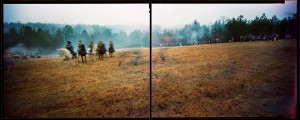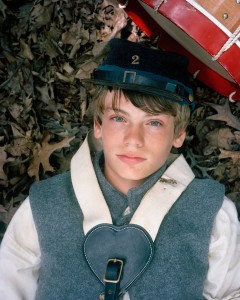
Eliot Dudik making collaborative 8×10 direct positive photographs with W&L Prof. Christa Bowden’s large format class. Photo: Christa Bowden.
Artist Eliot Dudik exhibited his photographs “Broken Land/Still Lives” in Washington and Lee’s Staniar Gallery Oct. 9–Nov. 4, 2015. This exhibition of large-scale photographs by eastern Virginia-based artist Dudik includes prints from two recent series: In “Broken Land,” Dudik photographs Civil War battlefields, depicting them as contemporary landscapes in order to explore the similarities in cultural and political conflict between now and the period prior to the Civil War. He will also be sharing work from his “Still Lives” series, portraits of Civil War reenactors at the culmination of their performance.
Dudik is a visiting assistant professor of photography at the College of William & Mary in Williamsburg, Virginia. His work has been featured on CNN, and has been exhibited around the country. He was the recipient of the 2014 PhotoNOLA Prize and was selected for the Magenta Foundation’s Flash Forward 2015 festival.
About the author: Lindsay George’16 is a double major in Art History and English at Washington and Lee University. She assists Staniar Gallery director, Clover Archer. George is presently completing an honors thesis in art history in which she examines the adaptation of David Alfaro Siqueiros’s brand of muralism by Chicana and Chicano artists in the United States during the 1960s-1980s.
Toolkit for Eliot Dudik’s Broken Land and Still Lives
Created by Lindsay George

Eliot Dudik, Berlin Owen, Still Lives series, © Original artwork copyright 2016 Eliot Dudik. Reproduced with artist permission.
Eliot Dudik’s large-scale photographic prints from his Broken Land and Still Lives series work to reconstruct a visual remembrance of the American Civil War. In Broken Land, Dudik photographs Civil War battlefields, reimaging the landscapes in a contemporary context to evoke comparisons between our current political climate and the conflict that led up to the Civil War. In Still Lives, Dudik photographs portraits of Civil War reenactors following their performance in battle reenactments. Commenting on his Broken Land series, Dudik states:
Dudik’s work offers opportunities for cross-disciplinary study in the exploration of this purposeful historical meaning. From a historical perspective, Dudik suggests a parallel between American society at the time of the Civil War and in our contemporary period. Moreover, from the lens of journalism, Dudik’s work can be placed within a greater history of photo-journalism and raises questions of the ethics of photographing or reporting stories of human suffering and conflict.
Discussion and Activities
Dudik’s work can be related to a history lesson plan through the idea of cultural or historical inheritance. Through his Broken Land series, Dudik hopes to establish a connection between the American Civil War and contemporary American society—specifically in the way that past moments of conflict are relived or reactivated by current social and political issues. In his artist statement Dudik expresses a hope that his work opens a dialogue to explore this connection:
Consider the following photograph, Aiken, South Carolina.
© Original artwork copyright 2016 Eliot Dudik. Reproduced with artist permission.
Using this work as a point of reference, discussion questions will lead students to consider Dudik’s art as a medium that bridges the gap between past and present:
- Consider the visual presentation of the work by itself. What differences are there between the left and right panels of the photograph? Look at the figures in the image. How do they appear differently and what effect does this have on the viewer’s impression of the work?
- Relate observations from the first discussion point to concepts of heritage and the passage of time. Does Dudik use specific imagery or iconography to evoke cultural heritage? Consider the work’s representation of time. Do the figures seem to be grounded in a single historical moment? Is it our historical moment?
- What parallels can be drawn from the social and political context of the Civil War and our own contemporary setting? Do you think Dudik has any specific events or issues in mind by drawing this comparison? What is the relationship between these events? Are these similarities in cultural history inherited or actively constructed?
- How does Dudik’s exercise in reconstructing a visual history of the past comment on the nature of history itself? If we can’t escape the cyclicality of history, are there at least more informed ways to interact with our national heritage?
Teaching from the Perspective of Journalism
Dudik cites famous Civil War photographers such as Matthew Brady as a major source of inspiration for his own photographs. Placing Dudik in the larger tradition of conflict photography, both his Broken Lands and Still Lives series problematize the ethics of photographing moments of war and violence. This discussion can be expanded to include other examples of conflict photography including Robert Capa and iconic images from the Vietnam War.
Consider the following photograph, Charles Kreger, 2nd Maryland Company.
© Original artwork copyright 2016 Eliot Dudik. Reproduced with artist permission.
- Think about the subject of this work and how it affects the viewer’s response. Would you feel differently about the work if the subject were older? If he were female?
- Compare Dudik’s work to the photography of Matthew Brady, Robert Capa, or another war photographer. How would your response to Dudik’s photograph be different if the subject were dead or depicted as suffering?
- What ethical precautions must photojournalists or journalists take when documenting conflict and human suffering? Does Dudik’s work seem to respond to or evoke any of these precautions?
Sources:
Students studying Dudik’s work from both a historical and journalistic perspective should also consult secondary sources to gain more insight into Dudik’s artistic purpose and the motivations of his work.
- eliotdudik.com
- Abigail Tucker, “A Photographic Requiem for America’s Civil War Battlefields: Walking far-flung battlefields to picture the nation’s defining tragedy in a modern light,” Smithsonian Magazine, July 2015.
- Canbra Hudson, “Broken Land,” Juxtapose Magazine, October 6, 2014.
- Mossless, “Mossless in America: Eliot Dudik,” Mossless Magazine, April 14, 2014.
- Aline Smithson, “Eliot Dudik: Broken Land,” Lenscratch: Fine Art Photography Daily, May 6. 2014.
- “Photography and the Civil War: Bringing the Battlefield to the Homefront,” Civilwar.org
This lesson was created by Lindsay George, a student at Washington and Lee University in Lexington, Virginia. This lesson can be used or adapted by other educators for educational purposes with attribution to George. None of this material may be used for commercial purposes. Copyright of original artworks belongs to the artist. Reproduced with permission from the artist. Please contact Andrea Lepage for information about the lesson or the Teaching with UCAH Project: lepagea@wlu.edu or (540) 458-8305.

Toolkit Lesson for Eliot Dudik by Lindsay George is licensed under a Creative Commons Attribution-NonCommercial-ShareAlike 4.0 International License.


